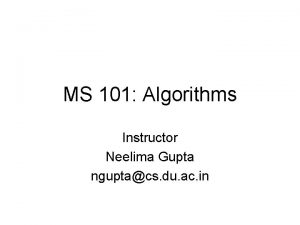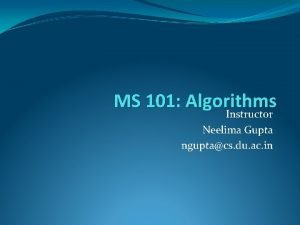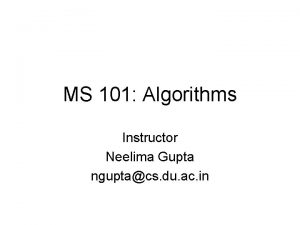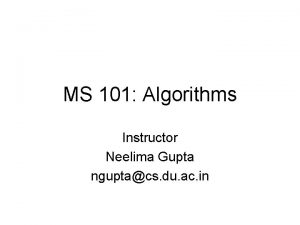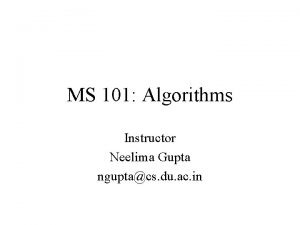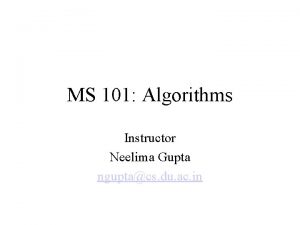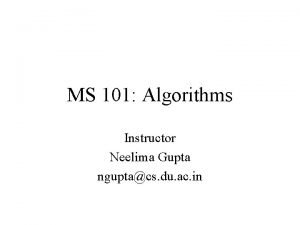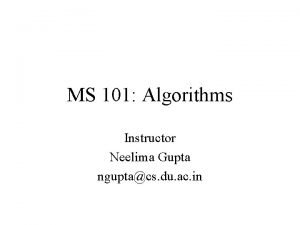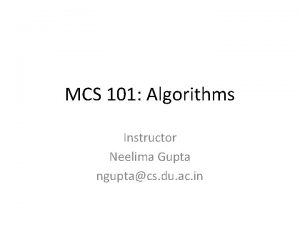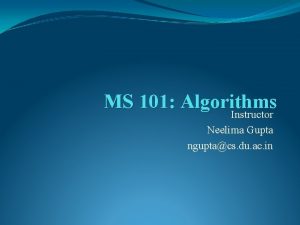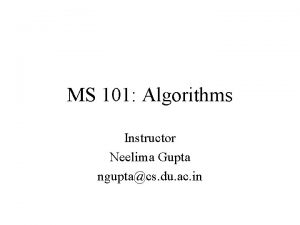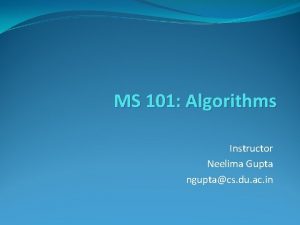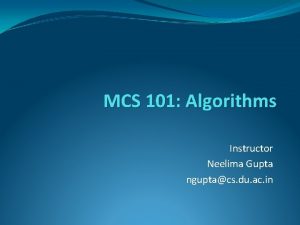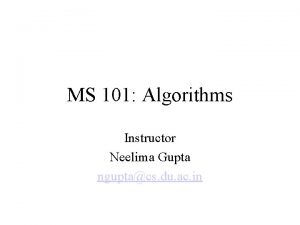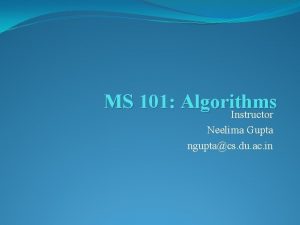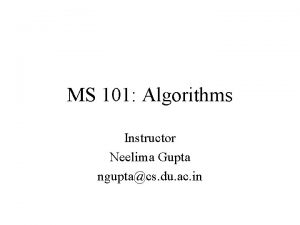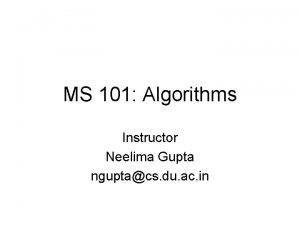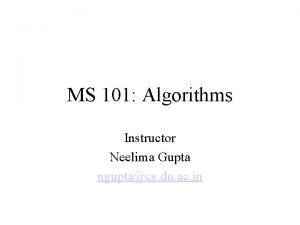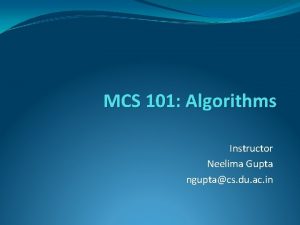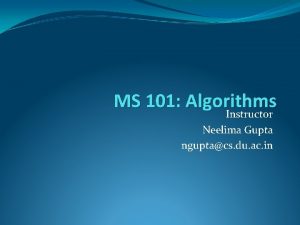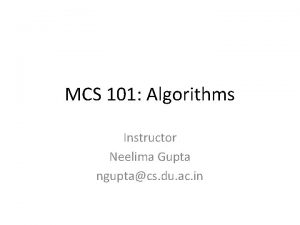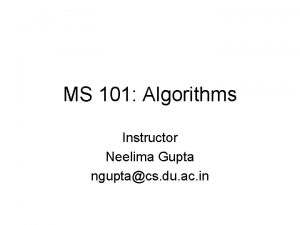MS 101 Algorithms Instructor Neelima Gupta nguptacs du























- Slides: 23

MS 101: Algorithms Instructor Neelima Gupta ngupta@cs. du. ac. in

Table Of Contents Solving Recurrences The Master Theorem

Recurrence Relations

Recurrences • The expression: is a recurrence. – Recurrence: an equation that describes a function in terms of its value on smaller functions

Recurrence Examples

Solving Recurrences • Substitution method • Iteration method • Master method

Solving Recurrences • The substitution method (CLR 4. 1) – “Making a good guess” method – Guess the form of the answer, then use induction to find the constants and show that solution works – Examples: • T(n) = 2 T(n/2) + (n) T(n) = (n lg n) • T(n) = 2 T( n/2 ) + n ? ? ?

Solving Recurrences • The substitution method (CLR 4. 1) – “Making a good guess” method – Guess the form of the answer, then use induction to find the constants and show that solution works – Examples: • T(n) = 2 T(n/2) + (n) T(n) = (n lg n) • T(n) = 2 T( n/2 ) + n T(n) = (n lg n) • T(n) = 2 T( n/2 )+ 17) + n ? ? ?

Substitution method • Guess the form of the solution. • Use mathematical induction to find the constants and show that the solution works. The substitution method can be used to establish either upper or lower bounds on a recurrence.

An example (Substitution method ) • T(n) = 2 T(floor(n/2) ) +n We guess that the solution is T(n)=0(n lg n). i. e. to show that T(n) ≤ cn lg n , for some constant c> 0 and n ≥ m. Assume that this bound holds for [n/2]. So , we get T(n) ≤ 2(c floor (n/2) lg(floor(n/2))) + n ≤ cn lg(n/2) + n = cn lg n – cn lg 2 + n = cn lg n – cn + n ≤ cn lg n where , the last step holds as long as c≥ 1.

• Boundary conditions : Suppose , T(1)=1 is the sole boundary condition of the recurrence. then , for n=1 , the bound T(n)≤ c n lg n yields T(1)≤ c lg 1=0 , which is at odds with T(1)=1. Thus , the base case of our inductive proof fails to hold. To overcome this difficulty , we can take advantage of the asymptotic notation which only requires us to prove T(n)≤c n lg n for n≥ m. The idea is to remove the difficult boundary condition T(1)= 1 from consideration. Thus , we can replace T(1) by T(2) as the base cases in the inductive proof , letting m=2.

Contd. . From the recurrence , with T(1) = 1, we get T(2)=4 We require T(2)≤ c 2 lg 2 It is clear that , any choice of c≥ 2 suffices for the base cases

Are we done? • Have we proved the case for n =3. • Have we proved that T(3) ≤ c 3 lg 3. • No. Since floor(3/2) = 1 and for n =1, it does not hold. So induction does not apply on n= 3. • From the recurrence, with T(1) = 1, we get T(3) = 5. The inductive proof that T(n) ≤ c n lg n for some constant c≥ 1 can now be completed by choosing c large enough that T(3)≤c 3 lg 3 also holds. It is clear that , any choice of c ≥ 2 is sufficient for this to hold. Thus we can conclude that T(n) ≤ c n lg n for any c ≥ 2 and n ≥ 2.

What if we have extra lower order terms?

Wrong Application of induction

Solving Recurrences • Another option is “iteration method” – Expand the recurrence – Work some algebra to express as a summation – Evaluate the summation • We will show some examples

Assignment 4 • Solve the following recurrence: T(n) = T(αn) + T(βn) + where 0 < α ≤ β < 1 n, Assume suitable initial conditions.

The Master Theorem • Given: a divide and conquer algorithm – An algorithm that divides the problem of size n into a subproblems, each of size n/b – Let the cost of each stage (i. e. , the work to divide the problem + combine solved subproblems) be described by the function f(n) • Then, the Master Theorem gives us a cookbook for the algorithm’s running time:

The Master Theorem • if T(n) = a. T(n/b) + f(n) then

Using The Master Method • T(n) = 9 T(n/3) + n – a=9, b=3, f(n) = n – nlog a = nlog 9 = (n 2) – Since f(n) = O(nlog 9 - ), where =1, case 1 applies: b 3 3 – Thus the solution is T(n) = (n 2)

More Examples of Master’s Theorem • • • T(n) = 3 T(n/5) + n T(n) = 2 T(n/2) + 1 T(n) = T(n/2) + n T(n) = T(n/2) + 1

When Master’s Theorem cannot be applied • T(n) = 2 T(n/2) + n logn • T(n) = 2 T(n/2) + n/ logn

Up Next Proving the correctness of Algorithms
 Neelima gupta delhi university
Neelima gupta delhi university Junagadh rock inscription
Junagadh rock inscription Clinux
Clinux Basic instructor course #1014
Basic instructor course #1014 Tcole basic instructor course
Tcole basic instructor course Wisconsin registry cbrf
Wisconsin registry cbrf Basic instructor course #1014
Basic instructor course #1014 Catia instructor
Catia instructor 15 sec illusion
15 sec illusion Tcole advanced instructor course
Tcole advanced instructor course Cisco certified trainer
Cisco certified trainer Tipos de participantes en un grupo
Tipos de participantes en un grupo Usmc jrotc vacancies
Usmc jrotc vacancies Nfpa 1403 instructor to student ratio
Nfpa 1403 instructor to student ratio The virtual instructor elements of art
The virtual instructor elements of art Delmar cengage learning instructor resources
Delmar cengage learning instructor resources Nra certified instructor logo
Nra certified instructor logo Pepperball training manual
Pepperball training manual Instructor
Instructor Mptc firearms
Mptc firearms Acr medical term
Acr medical term Tcole instructor course
Tcole instructor course Nrp instructor toolkit
Nrp instructor toolkit Human factors instructor
Human factors instructor
